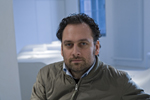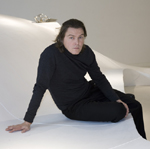
Interview

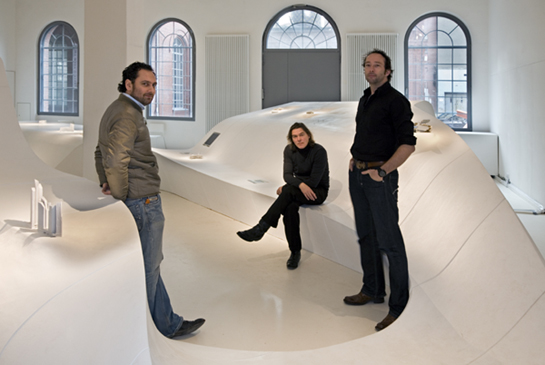
GRAFT
For the photo shoot we succeeded in assembling all three Grafts at the exhibition in Aedes Gallery. However, for the interview in the Berlin Graft studio in Heidestrasse
we were welcomed by just Lars Krückeberg and Thomas Willemeit – Wolfram
Putz was already on the road again.
How did you actually get to know each other?
Thomas Willemeit
We met for the first time on the very first day of Fresher’s Week at Braunschweig Technical University. We really got to know each other well in a choir there, which we founded ourselves. It was a jazz choir, and we even went as far as Italy and the United States with it.
Lars Krückeberg
And the third stage was the drawing class. To begin with we were all in different existing
ones, but it only became good fun when we all set up a drawing class together, which in fact is still going today. Drawing classes are an important part of the course at Braunschweig. The self-organized system of studying architecture there functions as an agreement between generations: young students help final-year students, who in turn give advice. It has produced a form of exchange of creative ideas we have been practicing ever since. Even today we till try to create the culture of the drawing class in the studio.
In 1998 you took part in the Architecture Internet Prize organized by BauNetz and won a prize. Were you already operating as Graft at that stage?
Lars Krückeberg
Yes. If I’m not mistaken that was the “Graft 4”project; it was certainly before number 10. It was very early on.
And what came after “Graft 4”?
Lars Krückeberg
A lot happened all at the same time. We went to Los Angeles, where to begin with we converted garages into studios, as you do if you are a young architect in L. A. – it’s your bread and butter, just to earn money.
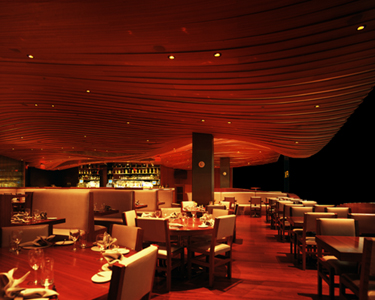
But we never relied on any one field alone. For example we also wrote, and helped launch the Las Vegas edition of Stadtbauwelt. We also did a lot for San Francisco and Silicon Valley, the e-commerce sector: new offices for Young Turks, who work 24/7 and have no private life whatever. How do you design areas where they can meet one another, how do you get these characters a girlfriend?
And finally, early on we tried our hand at art projects and were involved with the Biennial in Santa Fé. At the time we also designed the first home for Brad Pitt and have remained in contact with him ever since. To begin with we designed projects for him, and later on together with him.
What was it exactly that you built for him back then?
Lars Krückeberg
First of all it was his guest house. He was going to move into it for a time while he was having his beautiful Arts & Crafts home restored. That’s how we got to know him. Next to it there was another building he wanted to have demolished. But we had different ideas and told him he needed a place where he could think and work, where we could work together. So we completely converted it, making it into a totally different
building – the studio is now used for holding meetings and presentations.
Is your friendship with the star beneficial or harmful?
Thomas Willemeit
It would be a bit arrogant to call it harmful. It goes without saying that it is beneficial, and we are well aware of the fact. Now that we have become really good friends, and because we really value working with him on the basis of the work itself, for us the fact that he is famous is not an issue.
Hollywood and a few chic interiors: This is the image people have had of you for years now – and is totally out of date. What are you building these days?
Thomas Willemeit
In Berlin we are working on various interior conversions, a second dental practice – and we’re proposing a temporary art gallery on Schlossplatz, with which we are pretty much preoccupied.
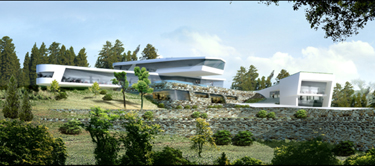
Lars Krückeberg
And we are also building a huge villa on the outskirts of the city. It’s a really exciting, ambitious project that we can’t actually say much about: The client doesn’t want it to attract public attention.
This lakeside villa is reminiscent of Scharoun’s Baensch building, which was also located overlooking the water. Is Scharoun, the organic designer, an influence on you?
Thomas Willemeit
Bingo! He produced some incredibly good projects that absolutely fascinated us. Take the Philharmonie concert hall in Berlin – a contemporary meeting point for music
if ever there was one. I know of none better, none that is so poetically charged and where there is such a good atmosphere. I had an opportunity to perform there once with a choir, now that was a great experience!
Colin St. John Wilson wrote a book about “forgotten modernity”. In it he addresses independent, organic and dynamic shapes in architecture. They are an inspiration to us. Wilson demonstrates how there have always been these threads running parallel
to mainstream modernity, even though in terms of appreciation they have been overshadowed by functional, rectangular and white architecture.
Let’s talk about your international projects.
Lars Krückeberg
We’re still building in the USA: First of all a pool complex with restaurants and bars on the largest building site in America, the City Center Project in Las Vegas. The overall design is the work of Cesar Pelli; Foster and Libeskind are building high-rises there. Designing pools might sound a bit trivial, but as far we are concerned it’s gigantic: There’s no bigger pool anywhere in the world!
In addition we’re designing a large hotel in New York in one of the World Trade Center towers. And finally, in collaboration with others, we are involved in an urban planning project in “post-Katrina New Orleans” to do with low-income housing, sustainability for the poor – in a part of town probably no one would otherwise enter.
Thomas Willemeit
In Georgia we are converting a large Interhotel and constructing nine villas on a slope
overlooking Tiflis. We also have the prospect of an urban planning project in the heart of the city, a major residential development covering 100,000 square meters. And finally in Latvia we are working on a residential building on the outskirts of Riga, right on the beach.
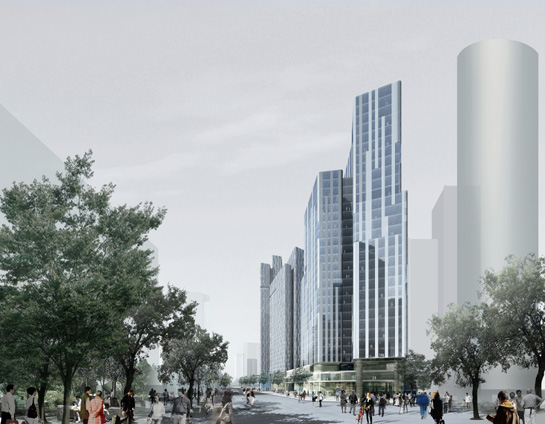
And in Asia?
Lars Krückeberg
In Tokyo we’re planning a ten-storey apartment block, above Roppongi Hills. In China there are several projects in Dalian. First, an entire bay with hotels, restaurants and shops in the shape of a sickle. And second, our biggest project of all: “Dalian Daily”. This comprises two residential towers, one 180, and the other 120 meters high, and an office block – overall an enormous volume, which the Lord Mayor has now approved.
The ground-breaking ceremony should be held later this year.
As far as things like dental practices and hotels are concerned you’ve very much developed your own signature. But how about when international high-rise projects like these are concerned? Aren’t you more or less told what to do?
Thomas Willemeit
Of course costs immediately begin to soar as soon as you break out of the traditional mold of a local form of construction. But we actually always take things to the limits – and doing that you can actually achieve quite a bit.
Lars Krückeberg
We need to differentiate here first and foremost between the building assignments. With an office block most clients are interested in revealing their own face, and pay-ing for the privilege. With residential high-rises, however, it’s a different matter. Here there is an infinite variety of clients with different requirements and wishes. The investor
is only interested in them for as long as it takes to sell all the apartments. When it comes to actually doing the building, that’s where savings are generally made – to the detriment of the quality.
Apartment blocks are one of the most difficult architectural tasks you can get. However,
as international architects we have to tackle them because, as the last Biennale demonstrated, the world’s major cities are becoming ever more concentrated. In China for example, where everybody is well aware that the masses are coming and apartments are needed, considering how many old city structures can be preserved would be for nostalgia purposes only.
Turning our attention to Germany again: What is behind your “Art Cloud” on Schlossplatz in Berlin?
Thomas Willemeit
When the magazine “Monopol” asked us to take part in the competition to produce sketches of ideas, the topic really grabbed us. It was to do with developing an image for a location that had had already been over-planned hundreds of thousands of times.
We very quickly decided that for the presentation of contemporary art we would design
a totally non-monumental, ephemeral shape. What emerged was this hovering something or other, which some people refer to as a cloud, and others as a UFO. What we are aiming to do is come up with a poetic expression for presenting art – and not the sort of “neutral” backdrop people frequently swear by, which there can’t be anyway. Each and every backdrop tells a story.
Bearing this particular project in mind: To what extent do computers influence your design process? Do you let the machine produce the shape, with the designer shouting “stop” at the right place?
Thomas Willemeit
Even with computer-aided designs someone has to pre-determine the conditions,
specifications and parameters. Our design for Schlossplatz was based on Michelangelo’s Capitol in Rome, a free shape, seemingly totally independent of the surrounding buildings and comprising two different circles. Having entered this geometry,
we used the computer to generate a shape that is curved in several places – a shape that previously you could only sculpt.

Lars Krückeberg
The decisive factor in this type of computer-generated shaping process is why say stop? And what sort of “stop” do we actually mean? – “Stop – I have to alter that again” or “stop – that’s it!” or then again “stop – the one before...” – Criteria with which to judge a design in all its complexity. Just to get Vitruvius involved: beauty, usefulness, sturdiness – they all have to feature. We really are filled with joy when we say “stop” and see that something really is beautiful.
Kant equates beauty with interestingness. That, ultimately, is what drives us: What makes something interesting?
To finish up with let’s move on from interesting to practical aspects. Jet-lag architects: How do you manage to run three studios on three continents? What sort of people do you have working for you?
Lars Krückeberg
“Jet-lag architects” is a nice way of putting it, and certainly hits the nail on the head far better than “jet-set architects”, which in the past we have also been called. Especially
if you have three studios and always sit in Coach Class: flying being exciting, now that was a long, long time ago.
The synergy effects we anticipated from the three studios are only now slowly beginning
to impact. We are now able to transfer people: Germans working in America who, like us back then, find out about new things. Who in a new cultural environment become quicker, more intelligent, more bastardized, more robust. And, vice-versa, we are now sending more and more Angelinos here to Berlin.
Germans mostly go to our newest studio in China. Getting the Chinese to leave their home country, on the other hand, is far more difficult. In principle we strive for a heterogeneous
blend – the more international, the better.
Thomas Willemeit
Incidentally, the ideal Graft employee works in our China Office: a Chinese, who studied
at Columbia and is married to an Austrian. Perfect synergy!
What do the three studios still have in common?
Lars Krückeberg
Los Angeles, Beijing and Berlin are cities in which there is an incredible amount of change, and tremendous dynamism. They are at one and the same time immensely beautiful and extremely ugly – urban planning laboratories. And that is precisely why we are there.
Thomas Willemeit
Change attracts us like magic. Wherever there is change we are jump at the opportunity.
It inspires us. Koolhaas turned his back on Berlin in horror: Berlin had been reunified
precisely at a time when intellectually it was not in a position to be. I wouldn’t go quite that far, though there are a few missed opportunities in the city. But let’s not complain about them because Berlin is big and full of energy – history moves on, and it’s up to the people there to now make something of it.
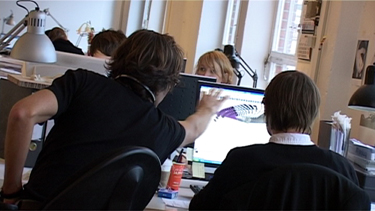
Benedikt Hotze was born in 1964 in Essen, studied architecture in Braunschweig and Lausanne, and is editor-in-chief of BauNetz since 1996.















































